Abstract
Building Information Modelling (BIM) is creating new opportunities for the Architecture, Engineering and Construction industry. One of them is the integration of the Building Sustainability Assessment (BSA) during the design process. Currently, an approach for using BIM to foster and optimise the application of BSA methods has not been clearly established yet, creating a knowledge gap on the application of BIM for sustainability assessment purposes. Thus, this paper analyses the current role of BIM to evaluate three BSA methods—LEED, BREEAM and SBTool. The current BIM applicability is assessed by performing a systematic review, where the criteria being assessed and the applied BIM software are identified. A comparison is made to determine which BSA method can currently take more advantage from BIM and to identify the number of assessed criteria from each one. Furthermore, the attractiveness of a BIM-based assessment for SBTool is analysed, facing the actual BIM scenario for LEED and BREEAM. Despite the restrictions, BIM use is increasing for sustainability purposes. Most of the analysed studies and identified software are still focused on the use of LEED for assessing sustainability during the design phase. However, BIM software capabilities can also support the assessment of the other BSA methods so that process replicability can happen. Among the most addressed criteria, the energy and material-related categories are the most eminent. Autodesk Revit is the most-used software. A BIM-based assessment for SBTool will have enough attractiveness. It can assess, at least, the same percentage of criteria as the other schemes, creating new opportunities to enhance building sustainability.
1. Introduction
The scientific community has already proved the relationship between the built environment and environmental problems [1]. Different actions have been taken to reduce buildings’ negative impact and fight against environmental issues. Among them are the Building Sustainability Assessment (BSA) methods, which aim at implementing and spreading sustainable principles, evaluating building performance and gathering information to support decision-making [2]. They are usually characterised by assessing several building features and aggregate the results into a sustainability score. Several methods have been developed all over the world by private and public organisations, according to their needs, characteristics and culture [2]. Despite the existence of different BSA methods, the following three are recognised as the basis of all the other approaches [3,4]: Building Research Establishment Environmental Assessment Method (BREEAM), Leadership in Energy and Environmental Design (LEED) and Sustainable Building Tool (SBTool). These will be used in this research and are presented in the next section.
The application of BSA methods requires the knowledge of a large amount of data, and it is a time-consuming and complicated process. Although they are intended to be used during the project phase to support decision-making, buildings are often assessed during the final construction stages. At these stages, making changes to improve building sustainability has higher costs and most times is unfeasible. This happens due to the lack of time and other resources from design teams during the project phase. Additionally, when a project change is introduced, all the assessment process must be repeated [5]. Thus, the application of BSA methods is usually unbearable given the deadlines of the projects, and this situation does not encourage designers to use it. To overcome this constraint, there is a need to reduce the assessment time and complexity, by automating and simplifying the sustainability assessment procedures. As a result, designers will be encouraged to improve the sustainability of their projects effectively.
With the recent deployment of Building Information Modelling (BIM), emerges the opportunity for BSA methods to benefit from its capabilities. BIM can be described as a working methodology, which makes it possible to manage the project’s 3D-model and data in a digital format during the building’s lifecycle [6]. All societies will benefit from it, with better and more efficient constructions that require fewer resources [7]. BIM and sustainability look for practical proposals for new architecture and engineering procedures, preserving the natural environment and ecosystems. Both concepts intend to achieve a new lifestyle, a modern environmental education and an updated perspective of the impact of human development on the planet. The BIM methodology has already been applied in different sustainable fields, as for energy modelling, acoustic analysis, water-use reduction, lifecycle analysis, construction waste management and even in supporting managers during the building’s operation [8]. Nevertheless, BIM’s main advantage lies in the collaborative process, where stakeholders can work on a central model and continuously share information about their project discipline. As a result, errors, incompatibilities and interferences between project disciplines are often identified in preliminary project stages, facilitating decision-making, as well as optimising costs and time.
By allowing multi-disciplinary information to be overlaid and grouped into a single model, BIM creates an excellent opportunity to incorporate sustainable measures in a project [9]. Furthermore, Azhar et al. [10] have identified that the pre-construction and project phases are the ones where decisions to improve building sustainability are supposed to be made. As this is also when projects can most benefit from BIM, the influence that it can have on building sustainability becomes clear. Wong and Zhou [11] argued that BSA methods should be used from the preliminary design stages, creating an integrated process and a more significant impact on the project. Designers are provided with detailed information to select the best sustainable solutions, allowing for the efficient development of high-performance buildings [12]. When BIM is used to improve the sustainability of a project, savings can reach up to 20% of the total project cost in 10 years [10].
In recent years, the attention of researchers about the application of BIM to facilitate the practical implementation of BSA methods has increased [8,13,14,15]. BSA method developers were driven to find new ways to integrate their products in this new paradigm [16,17]. To date, several criteria from different BSA methods have already been assessed with BIM. However, BIM it is still not used comprehensively in the implementation of the BSA methods [5]. The assessment of BSA methods exploits the full potential of BIM for building sustainability, as multi-disciplinary data must be assessed, with different BIM analyses and software. Among the most common advantages of using BIM to evaluate BSA methods, are the easier and faster data assessment, the resource-use reduction (time, money and human), improved process efficiency, automatic calculations and modifications updates [8,9,18,19]. With BIM, designers can quickly compare the sustainability performance of different solutions and select the ones that optimise the sustainability level of the project. Facing the potential capabilities of BIM for BSA methods, a review study from Chong [20] proposes that future BIM standards should include the requirements for a building sustainability assessment. Despite all the benefits, the scientific community have identified a set of existing limitations. Some issues are the lack of platforms and tools to assess building sustainability, the need to use several BIM tools to evaluate a single BSA method, the stakeholder awareness of sustainable issues or the interoperability restrictions between software [9,20,21]. A recent review from Santos et al. [15] has also identified a lack of research that considers all dimensions of sustainability, reinforcing Wong and Zhou’s [11] position. These authors have also affirmed that the full potential of BIM to sustainable construction is yet to be explored. Researchers suggest that future platforms and tools should be further developed to embrace more sustainable issues, and exchange format files should be improved to reduce errors when transferring BIM models (reducing the need for model checking and remodelling) [9,13,21].
Up to date, a set of generic reviews have been made about the application of BIM in sustainability issues [8,14,20]. Most of them are focused on the project phases, where BIM can enhance building sustainability. Therefore, there is still a lack of research about the practical implementation of BIM to assess specific BSA criteria with case studies. In a review from Ansah et al. [22], some frameworks and practical assessments were identified, but few insights were given about the most effective software and topic trend. However, they still have identified that most researchers tend to use BIM to assess LEED criteria (both for frameworks and practical assessments), with few BIM-based assessments on other BSA schemes. Azhar et al. [9] were one of the first researchers to approach the topic in 2011, by proposing a BIM framework that was able to assess 17 credits and two prerequisites from LEED. In practice, they have only assessed six credits and one prerequisite from LEED v2.2, which was significant progress at the time. More recently, Jalaei and Jrade [23,24] were able to assess a total of five prerequisites and 33 credits from LEED v3 (that belong to six different sustainability categories) with a BIM-based procedure.
Despite the greater focus on LEED, some approaches to other assessment schemes have been made. Edwards et al. [25] have used several different BIM software to assess eight credits from six categories belonging to the BREEAM UK Refurbishment and Fit-out 2014 scheme. Wong and Kuan [18] have gathered the necessary data for evaluating 26 out of 56 criteria from BEAM Plus (with Autodesk Revit, developed by Autodesk, Inc, San Rafael, CA, USA). They achieved a faster assessment with fewer resources when compared with the traditional method. For the Australian Green Star Building certification, Gandhi and Jupp [26] have assessed 66% of its credits. They argue that the capabilities of BIM were not used to their full potential. It is essential to develop BIM execution and coordination plans, which addresses the requirements of green building certification. Hoseini et al. [27] have suggested a conceptual framework, where 75% of the criteria from the New Zeeland Green Star certification can be supported by BIM, highlighting the importance of creating proper guidelines for BIM integration. By carrying out a Delphi analysis using 24 experts, Liu et al. [28] have identified that 31 out of 78 items from the Singapore Green Mark Non-Residential Buildings 2015 can be assessed with BIM and building performance analysis tools. Concerning the SBTool, Carvalho et al. [5] have presented a 3-stage framework for a BIM-based Application Programming Interface (API) to automate the assessment of 24 of the 25 criteria from the Portuguese residential version of this BSA scheme. They are currently developing a practical assessment of the identified criteria.
As it was possible to understand, different approaches and software are being used to integrate BIM in BSA methods. Additionally, several BSA methods and versions are also being applied, making it challenging to create a common understanding of the actual level of BIM integration. Facing the existing knowledge gaps, the present research aims at establishing a common understanding regarding which BSA criteria (from the most recognised schemes) were already practically assessed with a BIM-based procedure. To archive this goal, a systematic review will be carried out. Relevant publications from the past 10 years will be identified, to analyse the topic trend in terms of interest, applied software, preferred journals and addressed BSA method/version. Furthermore, it is also intended to investigate the applicability and attractiveness of a BIM-based process to assess SBTool, facing the existing procedures available for LEED and BREEAM.
The outcomes of this research will provide a basis and guidance for future researchers on the topic of the actual and prospective state of BIM integration in BSA methods. As BSA methods usually have similar criteria (applied procedures/software can be adapted to other sustainability schemes) [22], insights will also be gathered for process replicability.
2. Building Sustainability Assessment Methods
2.1. BREEAM
The Building Research Establishment Environmental Assessment Method (BREEAM) was created in 1990 by the Building Research Establishment (BRE) in the United Kingdom. BREEAM was launched as a credit award system for new office buildings but quickly developed systems for other buildings, such as homes, supermarkets or industrial buildings. BREEAM credits are divided over ten categories: Energy, Health and Wellbeing, Innovation, Land Use, Materials, Management, Pollution, Transport, Waste and Water [29]. Each category is subdivided into a set of assessment issues, each with its own aim and benchmarks. Every benchmark needs to be determined by a BREEAM expert assessor before credits can be assigned to the project. Once the assessment is entirely performed, the final score is determined by the sum of the weighted category scores [30]. BREEAM encompasses both mandatory and optional credits and allows to “trade” compulsory credits in different categories, while always setting minimum standards in essential areas.
Nowadays, the BRE has different BREEAM Standards available for Communities, Infrastructures, New Construction, In-use and Refurbishment and Fit-out, and it is recognised in more than 60 countries.
BRE has already started research about the capabilities of BIM. Currently, they have available different BIM-related services, such as certification, consultants, training and some research projects [31]. BRE has also released a BREEAM API to explore and integrate its rating data on thousands of certified building assessments across 50 countries, available for different tools, websites or software [16].
2.2. LEED
The first version of the Leadership in Energy and Environmental Design (LEED), developed by the United States Green Building Council (USGBC), dates from 1998. The aim was to provide building owners and operators with a concise framework to identify and implement green building solutions. It is mostly used in the United States of America, and it is recognised in more than 30 countries [9].
LEED is a point-based system, with a balance between known effective practices and emerging concepts, following six major categories: Sustainable Sites, Water Efficiency, Energy and Atmosphere, Materials and Resources, Indoor Environmental Quality and Innovation in Design. Using existing validated technologies, LEED assesses the environmental performance of buildings from an overall point of view during their lifecycle. The number of points that the project earns determines the certification level. In addition to credits, some sections of LEED include prerequisites that also must be satisfied, even though they do not count towards the building’s total points [30].
Nowadays, LEED has several rating systems, in four main areas: Building Design and Construction, Operations and Maintenance, Interior Design and Construction and Neighborhood Development. These systems cover different types of buildings, from residential, hospitals, retail, schools and warehouses, among others [32].
BIM applications on LEED are usually initiatives from researchers, private organisations or designers. Several authors have developed their specific applications for LEED, according to their needs. In 2014, the USGBC released some applications for LEED automation: Autodesk apps for LEED, COMNET Energy Modeling Portal, Greengrade LEED Management Software, Green Wizard, IES Tap for LEED, Tracker Plus LEED and Trane [17].
2.3. SBTool
The international initiative for a Sustainable Built Environment (iiSBE) developed the Sustainable Building Tool (SBTool). This method is considered one of the most comprehensive of all the BSA methods and has the flexibility to be adjusted to the local conditions of each region [2,3]. This feature allows to compare the sustainability level of buildings from different countries.
SBTool has influenced the national rating systems of Austria, Spain, Japan and South Korea. Custom versions have been introduced in Italy, Czech Republic and Portugal [33]. It can be adapted to assess the sustainability level of different type of buildings, such as houses, offices, schools or medical facilities, and already has versions for urban neighbourhoods.
SBTool has a set of parameters with different weights according to the national standards and practices. Each parameter is classified with a qualitative “score” that results from the comparison between two benchmarks: best and conventional practice. After weighing all the parameters, a final sustainable classification is given to the building. The parameter weights and the benchmarks must reflect a country’s characteristics and specific factors [2]. The system covers a wide range of sustainable building issues. The scope can be modified to be as narrow or as broad as desired, from more than 100 criteria to half a dozen. Parameter weights can also be adjusted to region-specific and site-specific factors.
3. Methodology
Facing the existing literature gap about the application of BIM to evaluate BSA methods criteria, the main objective of this study is to understand the actual practical implementation of BIM to evaluate BSA criteria. The goal is to identify which BSA criteria are available (and proved) to be assessed with BIM, as well as the most effective BIM software for such kind of analysis. It is also intended to analyse the topic trend in the past 10 years and the attractiveness level of BIM integration in the SBTool method, facing the two most known BSA schemes—LEED and BREEAM. Therefore, the following main research questions were established:
- What is the actual practical implementation of BIM to assess BSA criteria?
- Which percentage of BSA criteria can be assessed with BIM?
- What is the BIM software commonly used to assess BSA criteria?
- Which are the most preferred journals by researchers on the topic?
- Facing the current integration of BIM in LEED and BREEAM, will a BIM-automated assessment for SBTool be attractive enough?
To accurately answer the formulated research questions, a systematic review will be carried out, adapted from Tawfik et al.’s [34] guide. Figure 1 summarises all the procedure sequences for this study. After the research question(s) definition, a preliminary search will be performed to identify similar review studies and establish the contribution of this study. Then, the search strategy will be defined in terms of scope and keyword combinations. This review will only focus on publications that directly address the practical assessment of, at least, one criterion from the selected BSA methods—LEED, BREEAM and SBTool. These BSA methods were selected as they provide the basis for all the other existing frameworks [3,4].

Figure 1.
Systematic review procedure.
The research boundaries were defined by identifying the inclusion and exclusion criteria. The considered period is between 2009 and 2019. There were no restrictions regarding country of origin, BSA method version and applied BIM software, but only English language publications were considered. Publications for which the full text is unavailable and abstract only publications were excluded from the analysis.
Regarding the database, Web of Science was chosen as a research engine, due to its broader citations database. It encompasses registers from most of the existing high-impact journals.
By applying all the criteria, publications for consideration will be gathered and exported to a reference citation manager to remove duplications and for filtering. First by title and abstract reading and, then, by full-text reading. Finally, after identifying all the key publications for the research, a manual search will be performed to add a couple of publications about the topic that did not appear when using the selected keywords.
To analyse all the results, the key publications will be organised through tables, covering the following information:
- year of publication;
- title;
- journal;
- addressed BSA method;
- assessed criteria;
- adopted software.
This data will be used to carry out a statistical analysis, where the following aspects will be identified: percentage of assessed credits from each BSA method, the most assessed categories, the most common applied software, the topic trend in the past 10 years and the journals with most publications on the topic. Based on the current state of implementation of BIM in LEED and BREEAM, the attractiveness of a BIM-based assessment for SBTool will be investigated, as well as the replicability level of the applied procedures in those schemes (when applicable).
4. Results
4.1. Related Review Studies—Idea Validation
A quick search about the application of BIM in BSA methods shows that different proposals are being used to include BIM in several BSA methods and versions. The results also show an increased interest in the topic, creating a need to identify which criteria were already assessed with BIM. Up to date, some systematic reviews have been done on the use of BIM in building sustainability, as presented in Table 1. The most common journal to publish BIM-based reviews is Automation in Construction with three publications, followed by the Sustainable Cities and Society journal with two publications. Understandably, most of the reviews are focused on the use of BIM in generic sustainability applications, as well as in different project lifecycle stages to improve building sustainability [8,14,20]. A trend was also verified, which concerns the review of BIM-based Life Cycle Assessments [35,36] and BIM. Common journals and top authors/citations were also already identified [15].

Table 1.
Related review studies.
Concerning the application of BIM in BSA methods, Santos et al. [15] have identified the potential of BIM to automate the BSA evaluation. Ansah et al. [22] have reviewed the application of BIM in several BSA methods, identifying the most-assessed scheme. However, the Ansah et al. review has focused both on frameworks and practical applications, with a limited characterisation about the applied software in each assessed criterion and category. Few insights were also given about the recent topic trend, most selected journals and BSA methods/version. Thus, the present review’s contribution stands out by aiming to extend the analysis by including more and only practical applications of BIM to assess BSA criteria. This review also intends to identify the applied BIM software, the research topic trend in the past 10 years as well as the most selected journals for publications. Thus, it will be possible to close the knowledge gap about the practical application of BIM in BSA methods and to analyse the percentage of criteria that can be BIM-automated from LEED and BREEAM. This result will provide a basis to analyse the future integration of BIM in the SBTool method facing the two most-recognised assessment schemes, both in terms of attractiveness and processes replicability.
4.2. Publications for Consideration
By applying the keyword combinations of the systematic review (Figure 1), the research on the Principal Collection of Web of Science returned a total of 245 peer-reviewed publications. By applying the reference manager citation filter for duplicated publications, only 83 publications were left for consideration. However, when reading the title and abstract from all the remaining publications, only 41 were left over regarding the assessment of BSA criteria from the selected schemes. The final filtration stage was performed by reading the 41 full-text publication (whenever available), resulting in 23 publications concerning the research question(s): 19 for LEED, two for BREEAM, one for both and one for SBTool. Finally, by performing a quick manual research, three additional publications were found outside the keyword combinations. One for LEED, one for BREEAM and another one for both schemes, achieving the final number of 26 publications for consideration. Figure 2 presents the Preferred Reporting Items for Systematic Reviews and Meta-Analyses (PRISMA) flow diagram with the search phases and number of records. The first exclusion phase represents the title and abstract filtering. Full-text publications that were excluded did not address the practical assessment of one or more BSA criteria.
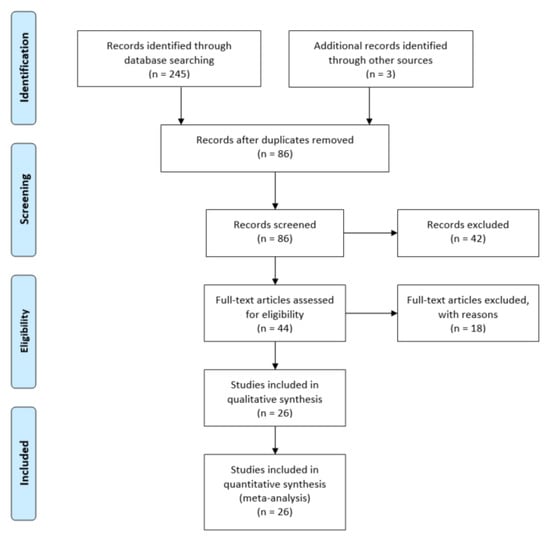
Figure 2.
PRISMA flow diagram [37].
Initial insights are in line with other review studies, pointing out the trend in research in assessing LEED criteria with BIM [26]. LEED has more than 400% of the studies compared with BREEAM. Concerning the SBTool, only one publication was found regarding a framework for a BIM-based assessment, which will be further explored later. All 26 publications will be used to conduct the statistical analysis.
4.3. BIM Application in BREEAM
From the performed analysis, five papers regarding the practical application of BIM in the BREEAM method are identified in Table 2. Between 2013 and 2019, different BREEAM versions have been addressed in all five publications. With the data from Table 2, Figure 3 was organised to present the BREEAM categories that were assessed using BIM. A commonly assessed category is Energy, attended in 4 out of 5 studies, followed by the Materials category, addressed in three studies. In total, the identified studies have assessed 20 different BREEAM criteria, in the categories of Materials, Energy, Land Use and Ecology, Management, Water, Waste, Health and Wellbeing and Pollution (8 categories out of 10). The Innovation and Transport categories have no assessed criteria. A common BREEAM version was used to understand the percentage of credits available to assess with BIM. As all the addressed versions are different, it is hard to define a common percentage for all. Thus, this analysis was only made for BREEAM UK Refurbishment and Fit-out 2014, as it is the publication with most assessed criteria (eight credits). For this case, a BIM-based procedure was possible to apply for the assessment of 24% of the scheme version credits (8 out of 34). Nevertheless, identified authors usually were able to assess approximately seven credits from each BREEAM version.

Table 2.
BIM integration on BREEAM.
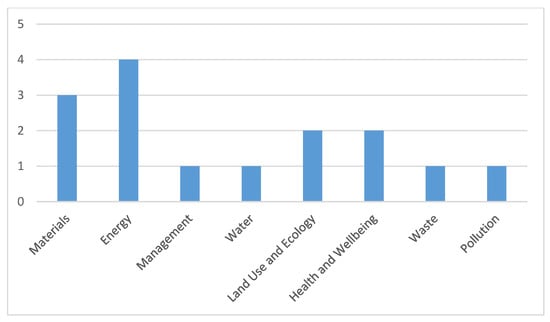
Figure 3.
BREEAM categories assessed with Building Information Modelling (BIM).
With regard to the software use (Figure 4), Autodesk Revit, IES-VE (IES, Glasgow, United Kingdom) and Visual Studio (Microsoft Corporation, Redmond, CA, USA) were identified as commonly applied to assess BREAM criteria (all used in 2 out of 5 studies). In total, 16 different software were used to assess 20 BREEAM criteria.
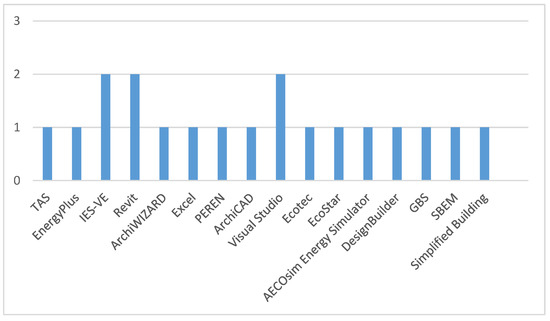
Figure 4.
Applied software to assess BREEAM criteria.
Concerning the preferred journal by researchers, Automation in Construction has been chosen for the publication of 2 out of 5 studies. Only one publication was found for the remaining three journals.
4.4. BIM Application in LEED
According to the analysis, LEED is the most-used BSA method by researchers regarding the use of BIM. As presented in Table 3, 22 from the 26 identified studies have addressed, at least, one LEED credit, between 2011 and 2019. The most used LEED version by researchers is BD+C: New Construction v3 (2009) is addressed in nine publications, followed by BD+C: New Construction v4 addressed in five papers. Figure 5 presents the different versions applied in the identified publications. Note also for the application of different LEED versions in school buildings, which have happened in three publications.

Table 3.
BIM integration on LEED.
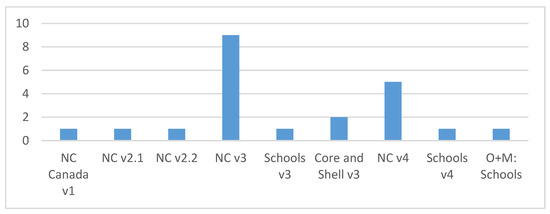
Figure 5.
Addressed LEED versions.
All LEED categories have been assessed somehow in the identified studies, as presented in Figure 6. The most common assessed credits are from the Materials and Resources category, addressed in 9 out of 22 publications. The following categories are Energy and Atmosphere (8), Sustainable Sites (7) and Indoor Environmental Quality (6). All the other categories have only been assessed in one publication. In total, the selected articles have assessed 84 different credits and 11 prerequisites from the categories of Sustainable Sites, Energy and Atmosphere, Materials and Resources, Indoor Environmental Quality, Innovation in Design Process, Regional Priority, Water Efficiency and Pilot-Credits in different LEED versions. Regarding LEED v3—the most addressed version—a total of five prerequisites and 33 credits have been assessed, representing 67% of all the scheme items (excluding Pilot Credits).
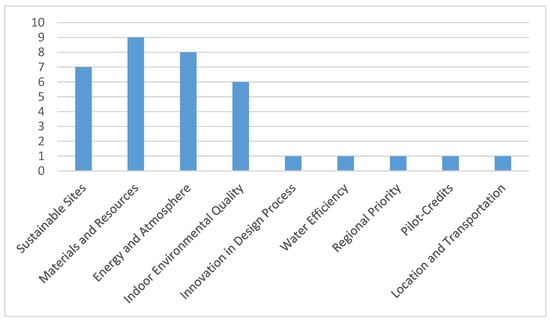
Figure 6.
Addressed LEED categories.
The most commonly used software is Autodesk Revit (19 out of 22) for 3D modulations and API’s development, applied in 76% of LEED identified publications. Microsoft Excel (Microsoft Corporation, Redmond, WA, USA) is the second most recorded software with 24% (used in 6 out of 22), followed by Dynamo (Autodesk, Inc., San Rafael, CA, USA) with 16% (4 out of 22). IES-VE, LEED Sustainable Sites and Google Maps (Google LCC, Mountain View, CA, USA) are the following, all with 12% (used in 4 out of 22). A total of 25 different software was used. Figure 7 presents the mentioned statistics.
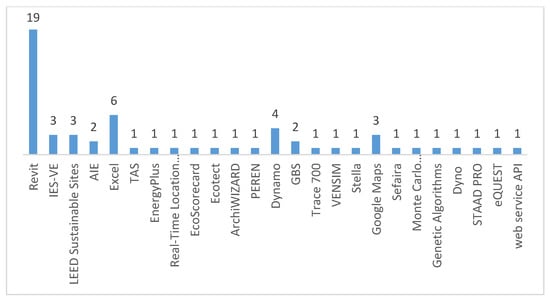
Figure 7.
Applied software to assess LEED criteria.
With regard to the most preferred journals for LEED-related publications, 4 out of 22 papers were published in Conference Proceedings. Automation in Construction followed with three publications, followed by the Journal of Architectural Computing and Journal of Cleaner Production, both with 2 articles.
4.5. BIM Application in SBTool
The application of BIM in SBTool is still in an initial stage, with the proposal of conceptual approaches. The only identified study regarding SBTool and BIM dates from 2019 and has identified a BIM-based framework to assess the SBToolPT-H—Portuguese method—to assess the sustainability of residential buildings [5]. This study proposed the creation of an Autodesk Revit API, which can directly and/or indirectly support the evaluation of 24 out of the 25 sustainability criteria. Autodesk Revit was identified as the most useful BIM software in the SBToolPT-H case. It has the capability to support the assessment of more than a dozen criteria. This is due to the criteria characteristics, which are mainly quantitative data from the building model. Authors have also identified several common software that can be used to assess the remaining criteria, such as Autodesk Green Building Studio (GBS, developed by Autodesk, Inc, San Rafael, USA), Google Maps or Microsoft Excel [5].
A practical application of the proposed framework was already preformed for 17 criteria on the categories of Land Use and Biodiversity (5 out of 5), Energy Efficiency (2 out of 2), Materials and Waste Management (5 out of 5) and Occupant’s Health and Comfort (5 out of 5). From all, 12 of these criteria were assessed by creating shared parameters and using the schedule function of Autodesk Revit (and Microsoft Excel as an interface). The two criteria from the Energy Efficiency category (and one from the Occupant’s Health and Comfort category) were assessed by exporting a 3D-model for Cypetherm REH (Cype Ingenieros, Alicante, Spain) and GBS, to perform the energy analysis. The two remaining criteria from the Occupant’s Health and Comfort category were evaluated by exporting the Autodesk Revit model to Cypetherm EPlus and Cypesound RRAE (both from Cype Ingenieros, Alicante, Spain). Currently, seven criteria are still requiring practical validation, namely on the water efficiency category (2), accessibility category (2), lifecycle environmental impact (1) and the economic dimension (2). With a BIM-based API, authors aim at optimising and automating the assessment procedure of SBToolPT-H and support designers during the project phase. This study was published in the Automation in Construction journal.
5. Discussion
From the performed analysis, it is possible to validate previous conclusions [22] about the most addressed BSA method. Between 2011 and 2019, 22 papers were published about the practical evaluation of LEED criteria, making it the most-preferred scheme for authors. Only five publications were found regarding BREEAM and one about a BIM-based framework for SBTool. Despite the research period that was set between 2009 and 2019 (the past 10 years), no publications about the topic were found in 2009 and 2010, including review articles.
A clear publication trend is noticed in the past years (Figure 8). Until 2015, the subject of BIM integration in BSA methods was still with low general interest, with a couple of publications per year. However, in 2016 the interest peak was witnessed with the publication of eight related papers. Despite the publication decrease in the following years, since 2018 an increased interest was again noticed, with a positive forecast for the next years. As BIM platforms and tools are continuously being developed, new approaches and processes are created to support building sustainability assessment.
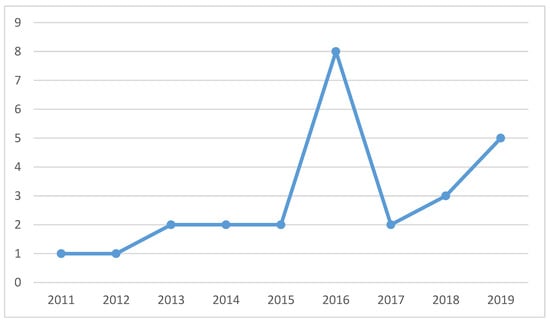
Figure 8.
Total articles published per year (LEED, BREEAM and SBTool).
Furthermore, the global concerns about environmental impacts will also promote research about building sustainability, supporting the positive prediction for the subsequent years. According to the Web of Science database, in 2019, five articles were published about the practical assessment of BSA methods with BIM. From those five articles, three were regarding LEED, one about BREEAM and one concerning SBTool.
Regarding the preferred journals, Automation in Construction stands out with six publications (Figure 9)—three on LEED, two on BREEAM and one on SBTool—representing 23,1% of the authors’ choices. As some of the most recognised and cited BIM-related articles (such as [9,13,18]) belongs to this journal, new researchers tend to try publications within this journal. Papers in conference proceedings have provided four related articles, representing 15,4%. A significant increase in these types of publications is expected in the following years. Papers that address only one or two criteria are usually insufficient for journal publication. Journal of Cleaner Production and Journal of Architectural Computing are the following ones, both with two publications each (7,7% each). All the other 12 identified journals had one related publication within the research period (3,8% each).
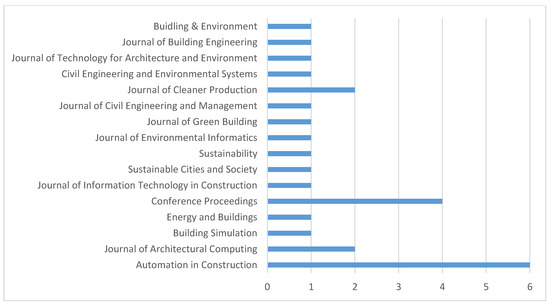
Figure 9.
Preferred journals (BREEAM, LEED and SBTool).
The most commonly assessed categories are materials and energy-related ones, both covered by the BREEAM and LEED versions, as presented in Figure 10. Twelve of the selected articles have addressed, at least, one criterion from those categories. Site-related and indoor environment-related categories are the following ones, approached in 10 and 8 papers, respectively. Overall, these are the most commonly assessed categories with BIM for both schemes. The identified articles have also evaluated the design, water and region-related criteria for LEED and BREEAM. Operation-related criteria were only assessed for the BREEAM method. This type of results was expectable since the existence and development of several BIM energy analysis tools adapted to region-specific contexts (data for energy and indoor environment-related categories). Material-related categories (quantitative data) are usually assessed through schedules, with the support of Microsoft Excel both for LEED and BREEAM. Site-related categories (majority assessed for LEED in eight publications) can benefit from the use of the LEED Sustainable Sites software. It allows designers to perform a full and concise assessment of the Sustainable Sites category from LEED.
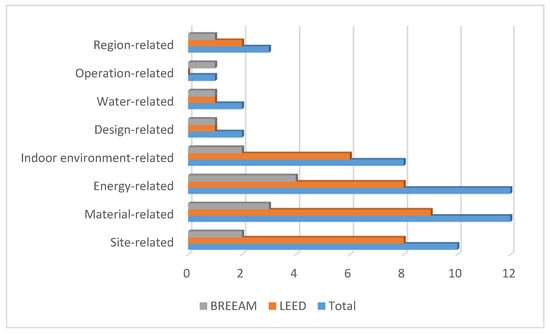
Figure 10.
Commonly assessed categories (BREEAM and LEED).
In total, 33 different software types have been used in LEED and BREEAM publications (25). Figure 11 presents all the software that have been used, at least, in two different studies. A clear trend on the use of Autodesk Revit is noticed, which has been selected in 20 out of 25 publications. Autodesk Revit is mostly used to create and edit BIM models (and then export to specific BIM analysis tools). Still, its capabilities are also used to assess quantitative criteria with the schedule function. Similar conclusions about the trend use were also reached by [35]. Microsoft Excel was the second most used, which was applied in six publications. Twenty-four other software types were also used in the identified publications. On average, 2,8 software types are used in each publication, with a minimum of 1 and a maximum of 8.
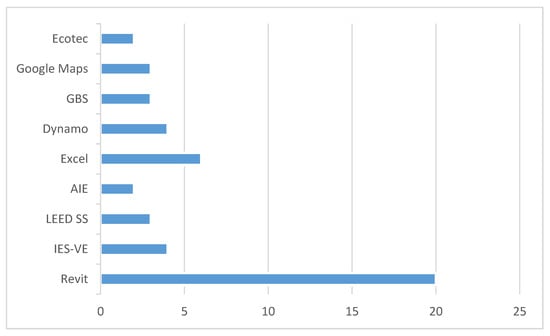
Figure 11.
Commonly used software (BREEAM and LEED).
In what concerns the development of a BIM-based assessment for SBTool, only one publication was identified. In this study, a BIM framework is proposed for the assessment of the Portuguese residential version—SBToolPT-H. This can be related to the need to adapt the international SBTool to region-specific factors. LEED and BREEAM have developed international versions, which can be almost directly applied worldwide.
Nevertheless, based on Carvalho et al. [5] and in the current work, in the SBToolPT-H framework, 24 out of 25 criteria were theoretically identified as possible to be evaluated with the support of BIM. Only one criterion regarding the building user guide (which is a sort of checklist) cannot benefit at all from the BIM methodology.
By practical implementation the theoretical framework, 17 criteria were already validated with the support of different BIM tools. Autodesk Revit and Microsoft Excel themselves can support the evaluation of 12 out of 25 criteria (site, material and indoor environment-related). These are mainly related to quantitative data from the site and building but also about specific building conditions. Five other criteria (energy and indoor environment-related) were also assessed by exporting an Autodesk Revit model for Cype and GBS software.
From the seven criteria that were not validated yet, two region-related criteria can be assessed with similar procedures (Google Maps API) as the ones applied by Chen et al. [48,51] for LEED. The water-related category (two criteria) can be assessed by using Autodesk Revit and GBS to forecast water consumption and water-saving measures. Three other criteria (LCA-related and economy-related) require the use of Autodesk Revit and Cype Arquimedes (Cype Ingenieros, Alicante, Spain) in combination with other software, such as GBS, Microsoft Excel or Cypetherm REH.
Overall, to assess 24 out of 25 criteria from SBToolPT-H with a BIM-based process, a total of eight different software types are required. However, half of the criteria can be evaluated only by Autodesk Revit and Microsoft Excel. The current practical integration of BIM in SBToolPT-H allows the evaluation of site-related, energy-related, material-related and indoor environment-related categories. These are the same sustainability assessment categories that is possible to assess in LEED and BREEAM.
Figure 12 presents a comparison between the criteria that can be currently assessed with BIM for LEED, BREEAM and SBTool. LEED NC v3 and BREEAM UK Refurbishment and Fit-out 2014 were used as they are the versions with more assessed criteria. For SBTool, both the theoretical proposal and the practical assessment were used to understand the actual and future expected BIM integration. When comparing all the schemes, it is possible to realise that BREEAM UK 2014 has the lowest BIM integration, with only 24% of the criteria being possible to be assessed with BIM. On the other hand, 67% of LEED v3 criteria (excluding Pilot Credits) and 68% of SBToolPT-H criteria can already be evaluated with BIM. According to the theoretical proposal, SBToolPT-H has the potential to be 96% assessed with the support of BIM (seven more criteria than the actual integration). However, these criteria are still requiring further practical validation. These features give enough attractiveness to a BIM-based assessment for SBToolPT-H. The use of BIM will enable the evaluation of, at least, the same percentage of criteria as the most assessed scheme, in identical categories and with fewer resources. However, it must be noticed that SBToolPT-H is the adaptation to a national context of the international scheme. Some adjustments should be made when replicating the BIM framework for other countries and/or building types.
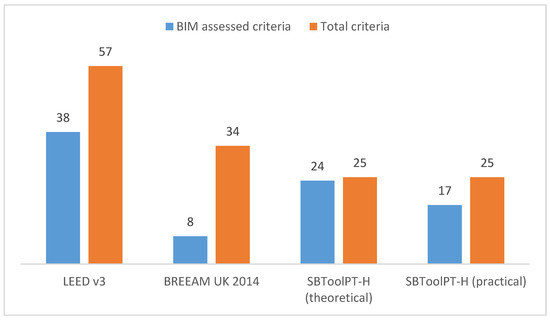
Figure 12.
Number of LEED, BREEAM and SBTool criteria that is possible to assess with BIM.
6. Conclusions
The construction industry is more and more embracing BIM as societies’ and authorities’ concerns about the negative impacts of buildings are increasing, with new approaches to improve their sustainability being sought. The application of BIM for sustainability purposes can reduce the number of required resources, as well as improve the overall quality of a building. Therefore, less energy will be required, and fewer emissions will be produced.
BSA methods are also taking advantage of BIM to foster and automate their assessment procedures. The potential of BIM lies in information share among the involved stakeholders and on process efficiency, significantly reducing the necessary time to perform a sustainability assessment. BIM also provides designers with detailed information to compare the impacts of different sustainable solutions and to assess the sustainability of their buildings since the project early stages.
The analysis made in this study has identified that, currently, the BIM method is mostly used to assess LEED sustainability criteria (22 out of 26 studies). With regard to the BSA categories, globally, energy-related and material-related categories have been attended to in 50% of the studies. Site-related categories have been addressed in 42% and indoor environment-related categories in 35%. Concerning the software, overall, Autodesk Revit was commonly used by researchers, adopted in 81% of the identified articles, followed by Microsoft Excel (27%). This happens due to the Autodesk Revit capacity to create, edit and export/import BIM models. Autodesk Revit is also frequently used when specific API is required or to gather quantitative data from the model. Regarding journals, a pattern was not completely identified. Nevertheless, Automation in Construction has provided 23% of the papers for this research. Conference Proceedings have provided 15% of the publications, and the Journal of Architectural Computing and Journal of Cleaner Production have both provided 7,8%. The remaining publications came from several different journals.
Overall, at least 67% of the LEED criteria and 24% of BREEAM criteria can currently be assessed with BIM. According to the analysis, a theoretical proposal aims to reach a 98% assessment of the SBTool criteria using BIM. At the moment, only 68% is already practically validated. Nevertheless, facing the current BIM integration on the three schemes, SBTool has a great attractiveness potential. It can evaluate the same (or more) criteria than LEED and BREEAM, on identical related categories (energy, materials, site and indoor environment).
Additionally, only by using Autodesk Revit and Microsoft Excel, it is possible to support the assessment of 48% of the SBTool criteria. It constitutes a comprehensive basis for the designer’s decision-making since the earlier design stages. Currently, despite the increased use of BIM to assess BSA methods, there is still a knowledge gap between them. BIM is not yet properly oriented towards sustainable building. As BSA methods are based on multi-disciplinary information, there is still a need to use several different BIM tools. Interoperability problems are also commonly found, requiring time for model checking. Moreover, there is a need to create common procedures and standards to support designers in performing a BSA with BIM. Procedures must be established and validated, so designers could achieve reliable and comparable results.
BSA developers are also aware of this paradigm and are continually developing new strategies to integrate BIM into their systems. All the studied methods already have conceptual or developed frameworks, which can be embedded in the BIM workflow, to improve and speed up the assessment procedures. Thus, BSA can be easier articulated with all the other project disciplines, improving information-sharing. From the analysis of the current and future applications of BIM in BSA methods, it is expected that the relation between both will be more reliable, smoother and faster. It will enable the total integration of BSA in the collaborative process and promote the efficient development of high-performance buildings.
This study outcomes reinforce the actual knowledge on the topic and establish a basis for future research. It identified which BSA criteria/categories can already be assessed using BIM and which software is commonly used to implement this process. The attractiveness of a new BIM-automated assessment for SBTool and the replicability of the new approach to the BREEAM and LEED methods was also analysed.
For future research (and based on the limitations of the actual study), more databases as well as more keyword combinations should be included in a more comprehensive review. Furthermore, other BSA methods, such as Green Star, DGNB or BEAM, should be included to create a broader basis and knowledge on the topic.
Author Contributions
Validation, J.P.C., L.B. and R.M.; Formal Analysis, L.B. and R.M.; Investigation, J.P.C.; Writing—Original Draft Preparation, J.P.C.; Writing—Review & Editing, L.B. and R.M.; Supervision, L.B. and R.M.; and Funding Acquisition, J.P.C. All authors have read and agreed to the published version of the manuscript.
Funding
This research was funded by the Portuguese Foundation for Science and Technology, grant number SFRH/BD/145735/2019.
Conflicts of Interest
The authors declare no conflict of interest.
References
- Li, Y.; Chen, X.; Wang, X.; Xu, Y.; Chen, P.-H. A review of studies on green building assessment methods by comparative analysis. Energy Build. 2017, 146, 152–159. [Google Scholar] [CrossRef]
- Mateus, R.; Bragança, L. Sustainability assessment and rating of buildings: Developing the methodology SBToolPT–H. Build. Environ. 2011, 46, 1962–1971. [Google Scholar] [CrossRef]
- Kamaruzzaman, S.N.; Salleh, H.; Lou, E.C.W.; Edwards, R.; Wong, P.F. Assessment Schemes for Sustainability Design through BIM: Lessons Learnt. In MATEC Web of Conferences, Proceedings of the 4th International Building Control Conference, EDP Sciences, Kuala Lumpur, Malaysia, 7–8 March 2016; Kamaruzzaman, S.N.B., Ali, A.S.B., Azmi, N.F.B., Chua, S.J.L., Eds.; MATEC Web of Conf. 66: Kuala Lumpur, Malaysia, 2016; p. 00080. [Google Scholar] [CrossRef]
- Sanhudo, L.P.N.; Martins, J.P.d.P. Building information modelling for an automated building sustainability assessment. Civ. Eng. Environ. Syst. 2018, 35, 99–116. [Google Scholar] [CrossRef]
- Carvalho, J.P.; Bragança, L.; Mateus, R. Optimising building sustainability assessment using BIM. Autom. Constr. 2019, 102, 170–182. [Google Scholar] [CrossRef]
- Succar, B. Building information modelling framework: A research and delivery foundation for industry stakeholders. Autom. Constr. 2009, 18, 357–375. [Google Scholar] [CrossRef]
- Eastman, C.M. BIM Handbook: A Guide to Building Information Modeling for Owners, Managers, Designers, Engineers and Contractors; John Wiley & Sons: Hoboken, NJ, USA, 2011. [Google Scholar]
- Lu, Y.; Wu, Z.; Chang, R.; Li, Y. Building Information Modeling (BIM) for green buildings: A critical review and future directions. Autom. Constr. 2017, 83, 134–148. [Google Scholar] [CrossRef]
- Azhar, S.; Carlton, W.A.; Olsen, D.; Ahmad, I. Building information modeling for sustainable design and LEED® rating analysis. Autom. Constr. 2011, 20, 217–224. [Google Scholar] [CrossRef]
- Azhar, S.; Brown, J.W.; Sattineni, A. A Case Study of Building Performance Analyses Using Building Information Modeling. In Proceedings of the 27th International Symposium on Automation and Robotics in Construction (ISARC-27), Bratislava, Slovakia, 25–27 June 2010. [Google Scholar] [CrossRef]
- Wong, J.K.W.; Zhou, J. Enhancing environmental sustainability over building life cycles through green BIM: A review. Autom. Constr. 2015, 57, 156–165. [Google Scholar] [CrossRef]
- Motawa, I.; Carter, K. Sustainable BIM-based Evaluation of Buildings. Procedia-Soc. Behav. Sci. 2013, 74, 419–428. [Google Scholar] [CrossRef]
- Ilhan, B.; Yaman, H. Green building assessment tool (GBAT) for integrated BIM-based design decisions. Autom. Constr. 2016, 70, 26–37. [Google Scholar] [CrossRef]
- Díaz-López, C.; Carpio, M.; Martín-Morales, M.; Zamorano, M. Analysis of the scientific evolution of sustainable building assessment methods. Sustain. Cities Soc. 2019, 49, 101610. [Google Scholar] [CrossRef]
- Santos, R.; Costa, A.A.; Silvestre, J.D.; Pyl, L. Informetric analysis and review of literature on the role of BIM in sustainable construction. Autom. Constr. 2019, 103, 221–234. [Google Scholar] [CrossRef]
- BRE, Breeam Api-Breeam, (n.d.). Available online: https://www.breeam.com/tools/breeam-api/ (accessed on 12 August 2019).
- Holmes, S. Green tools for LEED Users: LEED Apps and the LEED Dynamic Plaque |U.S. Green Building Council, (n.d.). Available online: https://www.usgbc.org/articles/green-tools-leed-users-leed-apps-and-leed-dynamic-plaque (accessed on 12 August 2019).
- Wong, J.K.-W.; Kuan, K.-L. Implementing’ BEAM Plus’ for BIM-based sustainability analysis. Autom. Constr. 2014, 44, 163–175. [Google Scholar] [CrossRef]
- Carvalho, J.P.; Silva, S.M.; Mateus, R. Using BIM to streamline the energy renovation processes of residential buildings during the early design stages. In Proceedings of the International Conference on Sustainable Housing Planning, Management and Usability (Sustainable Housing 2016), Porto, Portugal, 16–18 November 2016; Green Lines Institute for Sustainable Development, Ed.; pp. 435–444. Available online: http://repositorium.sdum.uminho.pt/handle/1822/43388 (accessed on 13 March 2019).
- Chong, H.-Y.; Lee, C.-Y.; Wang, X. A mixed review of the adoption of Building Information Modelling (BIM) for sustainability. J. Clean. Prod. 2017, 142, 4114–4126. [Google Scholar] [CrossRef]
- Liu, Z.; Osmani, M.; Demian, P.; Baldwin, A. A BIM-aided construction waste minimisation framework. Autom. Constr. 2015, 59, 1–23. [Google Scholar] [CrossRef]
- Ansah, M.K.; Chen, X.; Yang, H.; Lu, L.; Lam, P.T.I. A review and outlook for integrated BIM application in green building assessment. Sustain. Cities Soc. 2019, 48, 101576. [Google Scholar] [CrossRef]
- Jrade, A.; Jalaei, F. Integrating building information modelling with sustainability to design building projects at the conceptual stage. Build. Simul. 2013, 6, 429–444. [Google Scholar] [CrossRef]
- Jalaei, F.; Jrade, A. Integrating building information modeling (BIM) and LEED system at the conceptual design stage of sustainable buildings. Sustain. Cities Soc. 2015, 18, 95–107. [Google Scholar] [CrossRef]
- Edwards, R.E.; Lou, E.; Bataw, A.; Kamaruzzaman, S.N.; Johnson, C. Sustainability-led design: Feasibility of incorporating whole-life cycle energy assessment into BIM for refurbishment projects. J. Build. Eng. 2019, 24, 100697. [Google Scholar] [CrossRef]
- Gandhi, S.; Jupp, J. BIM and Australian Green Star Building Certification. In Computing in Civil and Building Engineering; American Society of Civil Engineers: Reston, VA, USA, 2014; pp. 275–282. [Google Scholar] [CrossRef]
- GhaffarianHoseini, A.; Doan, D.T.; Naismith, N.; Tookey, J.; GhaffarianHoseini, A. Amplifying the practicality of contemporary building information modelling (BIM) implementations for New Zealand green building certification (Green Star). Eng. Constr. Archit. Manag. 2017, 24, 696–714. [Google Scholar] [CrossRef]
- Liu, Z.; Chen, K.; Peh, L.; Tan, K.W. A feasibility study of Building Information Modeling for Green Mark New Non-Residential Building (NRB): 2015 analysis. In Energy Procedia 143; Elsevier Ltd.: Amsterdam, The Netherlands, 2017; pp. 80–87. [Google Scholar] [CrossRef]
- BRE. How BREEAM Certification Works. 2018. Available online: https://www.breeam.com/discover/how-breeam-certification-works/ (accessed on 27 December 2018).
- Asdrubali, F.; D’Alessandro, F.; Schiavoni, S. A review of unconventional sustainable building insulation materials. Sustain. Mater. Technol. 2015, 4, 1–17. [Google Scholar] [CrossRef]
- BRE, BIM | BRE Group, (n.d.). Available online: https://www.bregroup.com/expertise/bim/ (accessed on 12 August 2019).
- USGBC, LEED Is Green Building. 2018. Available online: https://new.usgbc.org/leed (accessed on 27 December 2018).
- Larsson, N. SB Method and SBTool for 2011-Overview. 2011. Available online: http://www.iisbe.org/system/files/private/Nils%20Larsson_New%20SBTool%20Generic%20Framework.pdf (accessed on 11 December 2018).
- Tawfik, G.M.; Dila, K.A.S.; Mohamed, M.Y.F.; Tam, D.N.H.; Kien, N.D.; Ahmed, A.M.; Huy, N.T. A step by step guide for conducting a systematic review and meta-analysis with simulation data. Trop. Med. Health 2019, 47, 46. [Google Scholar] [CrossRef] [PubMed]
- Eleftheriadis, S.; Mumovic, D.; Greening, P. Life cycle energy efficiency in building structures: A review of current developments and future outlooks based on BIM capabilities. Renew. Sustain. Energy Rev. 2017, 67, 811–825. [Google Scholar] [CrossRef]
- Soust-Verdaguer, B.; Llatas, C.; García-Martínez, A. Critical review of bim-based LCA method to buildings. Energy Build. 2017, 136, 110–120. [Google Scholar] [CrossRef]
- Moher, D.; Liberati, A.; Tetzlaff, J.; Altman, D.G. Preferred Reporting Items for Systematic Reviews and Meta-Analyses: The PRISMA Statement. PLoS Med. 2009, 6, e1000097. [Google Scholar] [CrossRef]
- Schwartz, Y.; Raslan, R. Variations in results of building energy simulation tools, and their impact on BREEAM and LEED ratings: A case study. Energy Build. 2013, 62, 350–359. [Google Scholar] [CrossRef]
- Salgueiro, I.B.; Ferries, B. An “Environmental BIM” Approach for the Architectural Schematic Design Stage. Int. J. Archit. Comput. 2015, 13, 299–312. [Google Scholar] [CrossRef]
- Oti, A.H.; Tizani, W.; Abanda, F.H.; Jaly-Zada, A.; Tah, J.H.M. Structural sustainability appraisal in BIM. Autom. Constr. 2016, 69, 44–58. [Google Scholar] [CrossRef]
- Biswas, T.; Krishnamurti, R. Data Sharing for Sustainable Building Assessment. Int. J. Archit. Comput. 2012, 10, 555–574. [Google Scholar] [CrossRef]
- Zhang, C.; Chen, J.; Sun, X.; Hammad, A. Lifecycle evaluation of building sustainability using BIM and RTLS. In Proceedings of the Winter Simulation Conference 2014, IEEE, Savannah, GA, USA, 7–10 December 2014; pp. 3236–3247. [Google Scholar] [CrossRef]
- Jalaei, F.; Jrade, A. Integrating Building Information Modeling (BIM) and Energy Analysis Tools with Green Building Certification System to Conceptually Design Sustainable Buildings. J. Inf. Technol. Constr. (ITcon) 2014, 19, 494–519. Available online: http://www.itcon.org/2014/29 (accessed on 12 August 2019).
- Viani, S.; Bergonzoni, G. Building Information Modeling (BIM) for LEED® IEQ category prerequisites and credits calculations. In EWork and EBusiness in Architecture, Engineering and Construction; Taylor & Francis Group: London, UK, 2016; Available online: https://www.academia.edu/28934605/Building_Information_Modeling_BIM_for_LEED_IEQ_category_prerequisites_and_credits_calculations (accessed on 12 August 2019).
- Zainudin, H.; Haron, N.A.; Bachek, S.H.; Jusoh, A. Utilisation of building information modeling (BIM) in planning an adaptive reuse project of a Traditional Malay House TMH. In Proceedings of the 2016 22nd International Conference on Virtual System & Multimedia (VSMM), IEEE, Kuala Lumpur, Malaysia, 17–21 October 2016; pp. 1–7. [Google Scholar] [CrossRef]
- Ryu, H.-S.; Park, K.-S.; Ryu, H.-S.; Park, K.-S. A Study on the LEED Energy Simulation Process Using BIM. Sustainability 2016, 8, 138. [Google Scholar] [CrossRef]
- Marzouk, M.; Azab, S.; Metawie, M. Framework for Sustainable Low-Income Housing Projects using Building Information Modeling. J. Environ. Inform. 2016, 28, 25–38. [Google Scholar] [CrossRef]
- Chen, P.H.; Nguyen, T.C. Integrating BIM and Web Map Service (WMS) for Green Building Certification. In Procedia Engineering; Elsevier Ltd: Amsterdam, The Netherlands, 2016; pp. 503–509. [Google Scholar] [CrossRef]
- Kensek, K.; Ding, Y.; Longcore, T. Green building and biodiversity: Facilitating bird friendly design with building information models. J. Green Build. 2016, 11, 116–130. [Google Scholar] [CrossRef]
- Akcay, E.C.; Arditi, D. Desired points at minimum cost in the “Optimise Energy Performance” credit of leed certification. J. Civ. Eng. Manag. 2017, 23, 796–805. [Google Scholar] [CrossRef]
- Chen, P.-H.; Nguyen, T.C. Integrating web map service and building information modeling for location and transportation analysis in green building certification process. Autom. Constr. 2017, 77, 52–66. [Google Scholar] [CrossRef]
- Marzouk, M.; Azab, S.; Metawie, M. BIM-based approach for optimising life cycle costs of sustainable buildings. J. Clean. Prod. 2018, 188, 217–226. [Google Scholar] [CrossRef]
- Raimondi, A.; Aguerre, M. MSOT: Materials selection optimisation in the LEED v4 protocol—A case study with BIM. J. Technol. Archit. Environ. 2018, 16, 270–280. [Google Scholar] [CrossRef]
- AbouHamad, M.; Abu-Hamd, M. Framework for construction system selection based on life cycle cost and sustainability assessment. J. Clean. Prod. 2019, 241, 118397. [Google Scholar] [CrossRef]
- Chen, P.H.; Nguyen, T.C. A BIM-WMS integrated decision support tool for supply chain management in construction. Autom. Constr. 2019, 98, 289–301. [Google Scholar] [CrossRef]
- Li, J.; Li, N.; Afsari, K.; Peng, J.; Wu, Z.; Cui, H. Integration of Building Information Modeling and Web Service Application Programming Interface for assessing building surroundings in early design stages. Build. Environ. 2019, 153, 91–100. [Google Scholar] [CrossRef]
© 2020 by the authors. Licensee MDPI, Basel, Switzerland. This article is an open access article distributed under the terms and conditions of the Creative Commons Attribution (CC BY) license (http://creativecommons.org/licenses/by/4.0/).